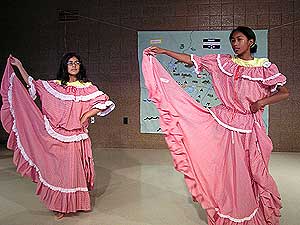|
Audio
Photos
Resources
|
 |
| Two high school girls learn the Cumbia at La Semana, a cultural camp in Minnesota for adoptees from Latin America. (MPR Photo/ Bianca Vazquez Toness) |
St. Paul, Minn. — On a recent summer day, a group of fourth graders is learning a traditional dance from El Salvador. Dressed in Latin American peasant costumes, the boys wear hats and the girls don long skirts, while their Brazilian instructor directs them to dance like professionals.
"Smile!" she calls out. "Hold hands with your partner, she's the most beautiful person on the planet!"
Dance classes are a big part of La Semana, a weeklong camp for kids adopted from Latin America.
"It's the one week of the year when my kids don't feel like the minority," says parent Carrie Noys.
She's brought her kids to this camp for more than a decade. She chose to adopt internationally because she thought it would take a long time to adopt domestically.
Noys says the biggest challenges have had little to do with adoption, but are the everyday joys and frustrations of being a parent.
Noys says it's important to bring her kids to this camp and immerse them in the culture they left. She's taken them back to visit Peru, where they were born, and has even hosted her son's birth mother when she visited Minnesota.
The international adoption trend began in the 1950s when Minnesotans and Californians started adopting Korean children. Those parents believed they should assimilate their kids as Americans as quickly as possible.
Those Korean adoptees have grown up and some have told stories of feeling isolated. Now the adoption movement preaches exposing kids to their cultural heritage.
Preserving cultural identity is certainly the mantra of Children's Home Society and Family Services. It's one of the three largest international adoption agencies in the country. Margie Miller heads the international program, which has placed more than 12,000 children from overseas into Minnesota homes.
"The major reason people adopt is because they've met children who've been adopted," Miller says. "They've seen the kids in school or church situations and say, 'We can do that, too.'"
Adoptive parents tend to fit a particular profile. Miller says they're between 30 and 50 years old. They "usually (adopt) because of infertility or want to grow their family in an international way."
Most of them are white, college-educated and middle to upper class.
Adoption scholars say the social climate makes Minnesota a prime spot for international adoption. It has a politically liberal tradition and a history of multiculturalism.
Some of the first white families who sought to adopt black children were in Minnesota, and families in Minnesota tended to just adopt more than in other places.
But things changed drastically in the 1970s. The U.S. Supreme Court ruled that schools couldn't kick out pregnant students, and it became more acceptable to be a single mother. The court also upheld women's right to an abortion. So, white women stopped giving up their kids for adoption.
When white families started trying to adopt black babies in greater numbers, the National Association of Black Social Workers spoke out against that practice. So many Minnesotans turned to adopt in Third World countries.
At first, many families said they wanted to do it as a rescue mission. But now, more say they want to build their families internationally.
That worries some experts. Sociologist Sara Dorow says some parents may be in denial of the circumstances that led the child's parents to give them up for adoption.
"Why is it that the flow is only in one particular direction, usually?" Dorow asks. "And what is it we might be doing differently to help these families who have to place these kids up for adoption?"
Dorow used to work for Children's Home Society and Family Services, helping with international adoption, before finishing her doctorate at the University of Minnesota. She now studies international adoption from China.
Dorow says she doesn't agree with some critics who have called international adoption, especially of Chinese girls, the latest fashion trend. But she says the process of international adoption can feel a little like shopping.
Parents often have certain demands, perhaps wanting a child of a certain gender, or a child with no mental or physical problems. And there's a large exchange of cash -- it costs nearly $30,000 to adopt overseas.
"Most agencies that I have talked to will say that they feel stuck between the fact that they always say rhetorically that the child is the client," Dorow says. "But in practice, the parent is the paying client."
Dorow says she doesn't oppose international adoption. She doesn't begrudge parents who want to start a family. However, she thinks parents -- and the government -- should think about how to change the circumstances that force families to give up their children.






